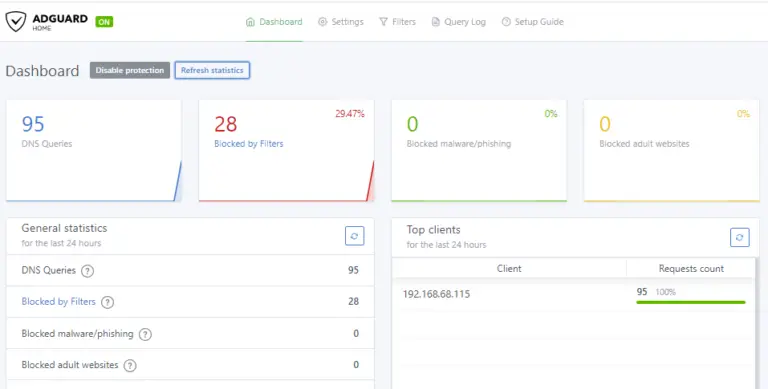
- #Pfsense adguard home install#
- #Pfsense adguard home 64 Bit#
- #Pfsense adguard home software#
- #Pfsense adguard home password#
- #Pfsense adguard home download#
Configuring DNSĪ feature that is absolutely required for me is the ability to have local hostname resolution within my network. That’s it, you now have a functional pfSense box, but there was one more bit if business in order to be satisfied with the system. Of course, this is just my personal preference. I just don’t care for how light the default theme is. My first order of business when logging in to the web configuration utility was to change the theme to a dark theme.
#Pfsense adguard home password#
I reset the Admin password for the webConfigurator, mostly because I didn’t remember setting it to begin with and wanted to get into it. Once it boots into a nice ASCII art menu, select 1 to Boot Multi User, which is default. In this case, I am getting a warning about my system battery voltage which I will address later. Just like any Linux distribution, once you have it on the USB media, and the machine boots from the drive, follow the directions. The installation is very straight forward on pfSense. Also note the version of pfSense is a moving target, so an exact copy from above is probably not going to be valid for long.

Replace /dev/sdX with the appropriate drive identification. pfSense-CE-memstick-2.4. | sudo dd of=/dev/sdX bs=1M
#Pfsense adguard home install#
The next thing to do is to install the image onto the USB drive.

Feel free to contact me directly and I’ll do my best to help you out. There are plenty of helpful folks out there. It should read /dev/sdb or something of that nature. Look for the latest entry corresponding to the USB device you just plugged in. To find out what the device name is of your USB drive, insert the drive into a USB port and run in terminal In my case, the drive is sdd, be very, VERY careful to not wipe out any of your other drives so pay close attention to what you are doing. Sudo dd if=/dev/zero of=/dev/sdX bs=1M count=1 I haven’t done this step before writing to a flash drive but who am I to argue with the developers? The instructions recommended erasing the disk partition table before writing. Then either your image or the sha256 is not right and need to be downloaded again. I haven’t seen anything other than OK so I couldn’t tell you what it’s like to not have an OK. I Put the downloads in the same folder and ran this:
#Pfsense adguard home download#
I have noticed on most sites, it seems as though that is just an expected understanding without much explanation, outside of the openSUSE download page, that is. Next I downloaded the corresponding sha256 file from here so that I could do the appropriate checksum action and ensure that it is a good download. Since the the time of installation, the version I downloaded to install was: pfSense-CE-memstick-2.4. The key point here is it is the amd64 version to correspond with my hardware. Conduct Checksum on the Downloaded Image It should be noted that the memstick version cannot be written using SUSE Studio Imagewriter. Downloading the Softwareįrom the pfSense download page I chose the AMD64 memstick version to put on a Dell Optiplex 745. This is assuming that should the machine loses power due to power failure, it will boot upon power being restored. The only major change I made to the configuration, outside of adding the second Ethernet card was to ensure that the machine would boot upon being powered. There really wasn’t much to do in configuring the hardware.
#Pfsense adguard home software#
Since it was recognized, I was ready to move on to the software portion of this little tech adventure. I inserted the card, started it up and jumped in the BIOS to make sure it was recognized. The machine has one PCI slot in it but there was a card with a COM port and PS/2 port on a card attached via ribbon cable to the main board that had to be removed first. As far as specifications go, it is at the bottom end of the recommended specifications to run pfSense but the plan for this isn’t anything real intense.

#Pfsense adguard home 64 Bit#
Since it requires a 64 bit system, I am using one of my newly inherited Dell Optiplex 745 machines. I had to start with an adequate piece of hardware to run pfSense. Since I have heard great things about it, I wanted to try it for myself on my own network to give me confidence to set it up for use in a small office setting. I have two reasons for setting up a pfSense box. I look at it as your first line of security to protect yet give you access to the machines or devices on your network. This is the first line of defense from those that would do you harm from the Internet to your home or business. Many Internet providers will supply their own edge device. A piece of hardware that is often overlooked in many homes and businesses is the the “edge device” or often just called a router.


 0 kommentar(er)
0 kommentar(er)
